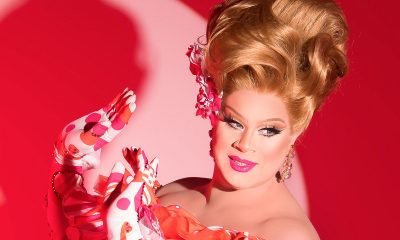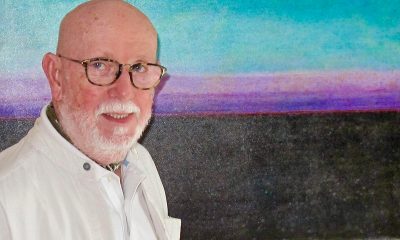a&e features
Ross Mathews shares ‘rossipes,’ cocktails, celeb gossip and more
New book ‘Name Drop’ is collection of his favorite happy hour tales
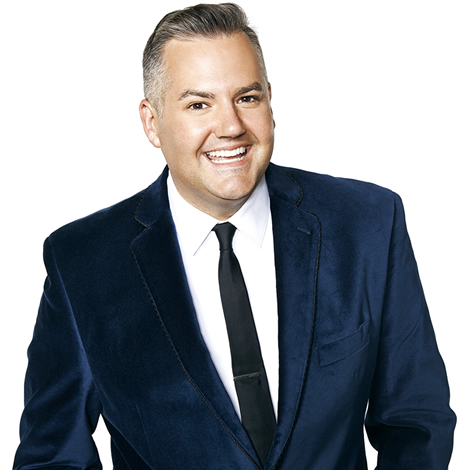
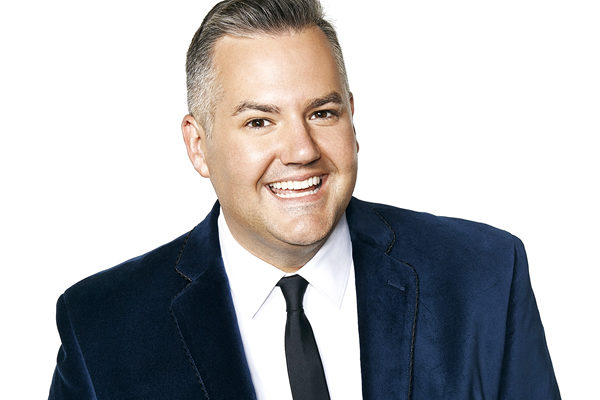
Ross Mathews ‘Name Drop’ Tour
Sunday, Feb. 9
7:30 p.m.
Miracle Theatre
535 8th St., S.E.
GA: $35
VIP (w/M&G): $100
Ross Mathews got his start on “The Tonight Show with Jay Leno” where he was known as “Ross the intern.”
The fabulously out gay guru has since been seen on many shows such as “Celebrity Fit Club,” “The Insider,” “Celebrity Big Brother” and, of course, “RuPaul’s Drag Race” where he’s been a staple at the judge’s table since season seven in 2015.
He launched his book tour for “Name Drop: the Really Good Celebrity Stories I Usually Only Tell at Happy Hour” (out Feb. 4) this week in New York and plays Washington Sunday night. Mathews, 40, dished on all that and more while driving to his second home (he lives mostly in Los Angeles) in Palm Springs last week.
WASHINGTON BLADE: How are things?
ROSS MATHEWS: Good. I feel like everyone has this sense of optimism this year that has been lacking the last couple years. People were like, “Ugh, God — this year can’t end soon enough,” but now, I don’t know, everyone I’ve talked to feels great about 2020 and so far so good. Also I’m driving to my place in Palm Springs, so I’m like in heaven.
BLADE: How were your holidays?
MATHEWS: It was really nice. I got to be with my family in Washington state and it was super nice, then I got to be back here in California and I went to Puerto Vallarta, which is another one of my happy places.
BLADE: Tell us about your book. How did it come about?
MATHEWS: The idea came to me in the shower. I was just like, “Oh my gosh, I wish I could tell everybody the stories I tell my friends at happy hour,” but then I thought, “But that’s so name-droppy.” Then I thought, “Screw it, just lean in — those are the stories people want to hear.” So “Name Drop” really is filled with celeb stories I usually only tell at happy hour and since it’s all about happy hour and I do cook every day, I thought why don’t I include some of my original rossipes in there so people can actually have happy hour while they’re reading the book, ‘cause that’s what the book feels like. It feels like you’re sitting down with me, ordering a drink and a bite and we’re just gushing over celebrities.
BLADE: So it’s cocktail and food recipes?
MATHEWS: Yes, there’s cocktails and rossipes for every single one and I pair them up with a chapter so for instance, I give Celine Dion “My Artichoke Heart Will Go On.” For Faye Dunaway, I give you my rossipe for “Endamame Dearest,” and it goes on from there.
BLADE: You had an encounter with Faye? Is she as scary as I fear she might be?
MATHEWS: I was too scared to ask her what I really wanted to ask her, but I thought it was so fascinating that I got to meet her, so I included it in the book. You know, some of these stories are when I had my dreams come true from people I’d loved forever, and some of these stories are about people who really disappointed me when I met them but I always say no celebrities were harmed in the making of this book. I tell the reader exactly what happened but I’m not out to hurt anybody.
BLADE: And these are all your own creations?
MATHEWS: Yes
BLADE: How did you get into that?
MATHEWS: So the cocktails are all sort of like my spin on cocktails that already exist and I make them original to me. The rossipes are all things I actually make. I’ve always loved cooking. I learned from my mom and I loved watching her. I love going to a restaurant and trying something and thinking, “Oh, I’d do it this way,” and then going home and cooking. I do that with Food Network too. I watch and go, “Huh — I would make it with this,” then I try it. Cooking is art — just another way to create.
BLADE: Do you have a favorite?
MATHEWS: Oh my gosh, I love them all. I make “Baked Ziti with a Z” for the Liza Minnelli story and that one’s really delicious.
BLADE: Please tell me there’s a chapter on Omarosa (she and Mathews were on “Celebrity Big Brother” together in 2018).
MATHEWS: Absolutely! We do an Omarosa Mimosa and then just a TV dinner because that chapter’s all about reality TV. Which by the way, an Omarosa Mimosa is made with blood orange juice.
BLADE: What was going through your head in real time when she was telling you all that stuff during your little tete-a-tete on “Big Brother”?
MATHEWS: Listen, I write all about that in the book. It was so surreal being locked away from the outside world for 30 days with cameras following us 24-7 and then Omarosa walks in and this was right after she had left the White House. I was fascinated by her and knew we had to talk about it or people wouldn’t think we were being real in that house. It’s impossible not to be real when they’re filming you 24 hours a day. So that conversation, to sit there and ask her those questions and what I was thinking and also what happened afterwards, which nobody knows about, that’s all in the book.
BLADE: Do you get a clothing allowance on “Drag Race”?
MATHEWS: No. I have to get my own wardrobe and of course, you have to step it up because you’re sitting next to RuPaul. I partner with Mr. Turk and I’m sucking up to friends who are designers. I’ve worked with Mr. Turk and Trina Turk for a long time and I’ve worn Tallia Orange before, so I try to find people who can partner with me so I’m not spending mazillions of dollars on these clothes.
BLADE: Is the stuff you wear on “Drag Race” the kind of stuff you wear in your private life or do you glam it up for the show?
MATHEWS: Well you have to wear something noticeable on that set. What am I going to do? Show up in corduroy or khakis? In real life, I love clothes but I’m not always in a suit. Usually I’m in like a jacket with a leopard scarf and a Gucci slide. When I go to Palm Springs, it’s elastic head to toe (laughs).
BLADE: Do you do your own shopping?
MATHEWS: I’ve had stylists in the past. My partner all those years, Salvador (Camerna), was my stylist but lately I’m not using a stylist. It’s just me partnering with various designers and trying to express myself however I feel that day. The other day I had on ripped jeans and boots and I was feeling all butch, like green Army Surplus jacket and right now I’m wearing Gucci fur slides and a leopard scarf, so I’m feeling more Nellie today. It’s fun to express fashion, always a joy.
BLADE: Was there ever a “Drag Race” contestant you thought went home too early?
MATHEWS: Yes. I’ve never disagreed with the winner, but I have opinions on who should stay and who should go. That’s part of my job, I get to argue my point to Ru who makes the ultimate decision. So I have of course thought somebody should have stayed who went home at a certain point, but the cream always rises to the top and I agree with every winner who’s been chosen.
BLADE: Did you ever feel somebody who sashayed away should have won the lip sync?
MATHEWS: (long pause) Yes (laughs). But I don’t want to give specific cases. Ru is the Supreme Court and I defer to Ru all the time. But there’ve been a couple times when someone won and I go, “Huh — I didn’t see that one coming.” But that’s not my job to decide that. I’m just there to give my two cents.
BLADE: Do you hang out with Michelle (Visage) and Carson (Kressley) outside the show?
MATHEWS: Absolutely. Michelle and I just went to lunch in Calabasas the other day. She got gluten-free grilled cheese. She’s like a sister to me and Carson’s like a brother. I love them all. And we really just make each other laugh all day long.
BLADE: You’re all so chummy now but Michelle had a rather prickly relationship with (former judge) Santino (Rice). Does a little tension there help the show?
MATHEWS: Well, I can’t really speak to her relationship with Santino, but Michelle and I are like brother and sister. If we disagree, we’re not gonna keep it in. I’ll tell her she’s nuts, but we laugh about it later. We have absolutely had strong disagreements where we each draw a line in the sand and we’ll never agree on something but then we go to lunch afterwards. I’m not afraid of her.
BLADE: Who’s been your all-time favorite “Drag Race” guest judge?
MATHEWS: Oh my gosh, there are so many. I can’t believe the people we get to sit next to. I’ll come home and say, “I just sat next to Lady Gaga for like 12 hours,” or Miley Cyrus. I have to be careful not to say some of the names coming up ‘cause they’ll blow you away, but I’ll get in so much trouble. It’s one of the greatest gifts of the show the artists that Ru and World of Wonder allow me access to. It blows me away.
BLADE: Who would be your dream judges?
MATHEWS: Liza, Cher, Bette, Madonna — you know, the icons.
BLADE: Do you guys write all your own puns for the runway commentary or do you have help?
MATHEWS: No, we come up with it as it’s happening. As we see it, we say it.
BLADE: They’re pretty clever most of the time. I’ve always thought, “They must get some help with this.”
MATHEWS: No, we just try to make each other laugh. There’s no better feeling than making really funny people laugh. There are some stinkers from time to time and the editors help us out.
BLADE: About how long does it take to tape a full “Drag Race” season?
MATHEWS: Well, there’s a lot going on. I don’t want to ruin it for people but of course, it takes longer than just what you see. There are outfit changes and you have to stop for production and sometimes there’s a lighting cue that goes wrong you have to redo. There’s a lot that goes into a production of this size but as someone who loves showmanship, I don’t want to give too much away.
BLADE: What’s the biggest thing being behind the scenes on these kinds of shows that stands out to you that you’d never have thought about as a viewer at home?
MATHEWS: Well, like the first time I went to the Oscars, I was staring at all the stars on the red carpet then you turn to the left and see 12 portapotties. I was like, “Wow, I didn’t know those were there,” they cut those out of the shots for TV. Or being in the “Big Brother” house and hearing the camera operators in the wall saying, “I’ve got a close up on Ross’s face, he’s going to bed.” I was like, “Oh my god, I didn’t think about that.” Or there’s a microphone hanging over the toilet, the one toilet you share with 11 other celebrities. It’s not all glamorous but it’s all a piece of the puzzle.
BLADE: Have you seen Ru’s new Netflix show?
MATHEWS: I have! Michelle and I went to the premiere. We were basically wearing the same red suit, it’s on my Instagram. It’s so great, I’m so proud of Ru. You know, Ru refuses to be put in any box. You think you know what Ru can do, then Ru goes, “Oh, I can also do this.”
BLADE: When Ru was on the cover of Vanity Fair in December, the article suggested he’s only knowable to a point, down to earth and candid in some ways — I’m paraphrasing — but also with a bit of aloofness, like he only lets you get so close or never totally lets his hair down. Is that your impression?
MATHEWS: Um, I can’t really speak for other people’s impressions of Ru, but I can tell you what Ru has been for me. Ru has been so kind and so supportive and so welcoming and you know, there’s one quote on the cover of my book and it’s a quote from Ru and that’s on purpose because for this phase of my career, Ru’s been the one who has sort of given me a platform and said, “Hey, look at this guy, he’s really funny.” ‘Cause Ru could have picked anybody for that seat next to him and so for me, he’s a mentor and a friend.
BLADE: You’ve made self-deprecating cracks about your sex life on “Drag Race.” You gettin’ any these days? Or dating anyone?
MATHEWS: (laughs) I am dating a lot actually. I never did this before. I didn’t really date in my 20s because I was figuring out how to be a famous person and I felt like a clown a little bit, so I felt like I had to choose between being funny or sexual. Then I got in a relationship and we were together for 10 years and now I found myself out dating again and I’m really confident now in who I am and I’ve never been single and confident at the same time, so I’m having a really good time dating. I find people fascinating. I like meeting people and I like learning from people and I think if you’re inquisitive and confident, you’re a really good dater.
BLADE: Reality TV and media can be rather soul sapping. And Ru is always spouting great spiritual wisdom. How do you refuel spiritually yourself?
MATHEWS: Not to sound cheesy, but I’m really fueled by living my dream. I don’t need anything else.
BLADE: Good luck with your book and tour.
MATHEWS: Thanks! Please come out. It’s just an hour and a half where we shut the door on the world, ‘cause everything’s fucked right now …
BLADE: Yeah, especially in Washington!
MATHEWS: I know, right? We just shut all that out and have some laughs.
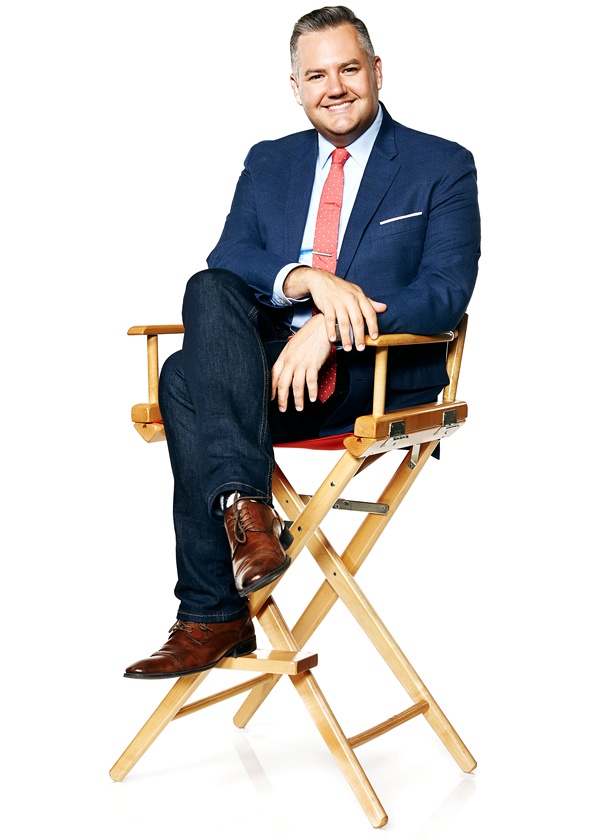
a&e features
Doug Spearman takes his chance
‘Noah’s Arc: The Movie’ debuted on Paramount+ last month
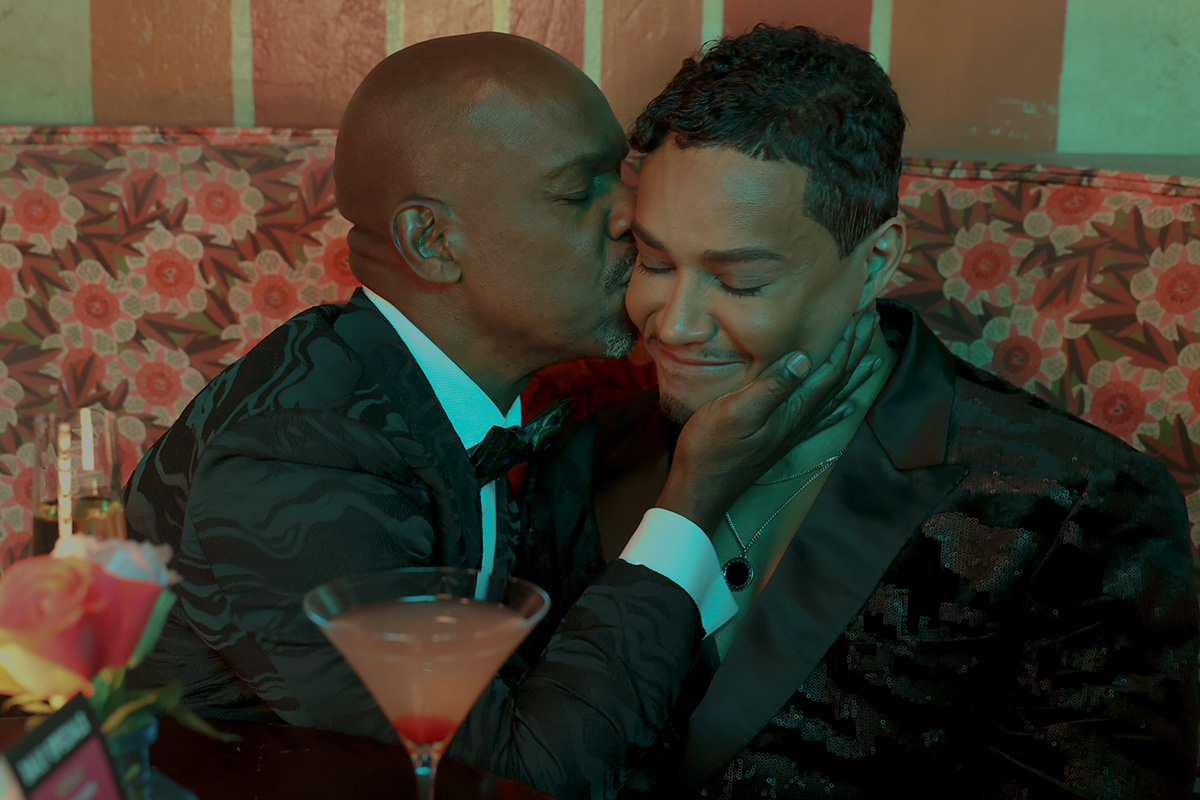
There’s no question that when Patrik-Ian Polk’s series “Noah’s Arc” premiered on Logo 20 years ago, it was a groundbreaking creation. The story of a group of Black gay men and their wonderful friendship. The titular arc was that of the cute main character, Noah (Darryl Stephens), and his close-knit circle of friends, including Chance played by gay actor Doug Spearman. This compelling and loving fraternity may, in fact, be what brought viewers back repeatedly, including a 2008 movie, “Noah’s Arc: Jumping the Broom,” as well as the 2020 “Noah’s Arc” short, and now, a new full-length feature “Noah’s Arc: The Movie,” debuting on Paramount+ on June 20. In the movie, filled with equal measures of laughs and tears, Chance, who has faced a devastating loss, finds his dependable friends there, ready to support and comfort him at a moment’s notice. I had the pleasure of speaking with Spearman the morning of the streaming premiere of “Noah’s Arc: The Movie.”
WASHINGTON BLADE: Doug, since the early 2000s, when the “Noah’s Arc” series premiered on Logo, you have been playing the character of Chance, including in the latest installment, “Noah’s Arc: The Movie.” What was it about Chance that appealed to you as an actor?
SPEARMAN: When Patrik (-Ian Polk) called me to ask me to play him (Chance), I was at JFK airport in the baggage claim, waiting for a suitcase. He explained what the part was. The thing that stuck out to me was the fact that Chance was in a long-term relationship with another Black man. And, they had a child; they had a 4-year-old daughter named Kenya. I had never seen two Black gay men raise a child on TV before. I thought it was the most revolutionary thing I’d ever seen. I immediately thought I’ve got to do this because that was something nobody had seen. I thought it was incredibly important to take the part.
BLADE: “Noah’s Arc: The Movie” was, once again, written and directed by Patrik-Ian Polk, who you just mentioned, is the creator of the entire franchise. What’s the secret to your long-standing working relationship?
SPEARMAN: [Laughs] the whole team, all of us, are like a band of brothers. We fight like brothers, we come together like brothers, we hash things out, we talk, because we’re all very different from our characters. I think the challenge of playing these guys and then uplifting these men, playing a part, especially something written by Patrik, is like solving a math equation. There’s always a challenge that’s enjoyable for me as an actor: to try to find out what it is that Patrik wants, and then how do I do it.
BLADE: I think you do a very good job of it.
SPEARMAN: Thank you very much
BLADE: In the years between “Jumping the Broom” and the new full-length movie, many changes have occurred, and the story addresses some of them, including gay widowhood, which is something that the aging community is now confronting, as well as mental health issues. Please say a few words about how you approached those subjects in the new movie.
SPEARMAN: I had a lot of loss in my life, right before we started shooting. Two months before we started shooting the first series, my mother died. I was going through the grief process through that whole first season. Since then, I’ve lost a lot of people in my life. In fact, when we started shooting the second season, the second week we were shooting, my ex died of a heart attack. I was having to fold that into what I was doing with my life on the set and off the set. You’ve got to show up and you’ve got to do your work. The first two seasons of “Noah’s Arc” are always tinged with the memory of grief. So, when I had to deal with the death that Chance faces (in the new movie), which is a significant death in his life, it wasn’t that hard to reach back, especially the scene in the graveyard. It was something that I unfortunately could pull from personal experience.
BLADE: Shifting gears, the movie features delightful cast surprises, including Jasmine Guy and TS Madison. Did you have a chance to interact with either or both when they were on set?
SPEARMAN: No, I didn’t have any scenes with Jasmine, and I missed her. I wish I had gotten to see her because I actually got to direct Jasmine for a CBS promo shoot for “Queen,” back in the early ‘90s. I had a huge crush on her when she was on “A Different World.” So, I really would have liked to reconnect. But TS and I got to see each other every day because I was in all her scenes. It was extraordinary being around somebody like that. That is one outspoken woman!
BLADE: Even though Beyoncé never makes an appearance in the movie, there’s a lot of talk about her. Would you say you are a Beyoncé fan?
SPEARMAN: Yes! I’m breathing! Yes, I’m a Beyoncé fan. I actually got the chance to meet her. I knew her mom. Her mom was extraordinary to me. She is in the second movie I directed. She also gave us a wedding gown to use in the very first scene of the movie. That family is extraordinarily important to me. Not only just to be a fan, but to be somebody who’s gotten to know them and work with them and see how hard they work. I don’t think anybody works as hard as Tina or Beyoncé.
BLADE: There was a recent news item about gay actor Benito Skinner of the Amazon Prime series “Overcompensating” being told not to bother auditioning for straight roles. As an out actor yourself, how important do you think it is for queer characters to be portrayed by queer actors, and vice versa?
SPEARMAN: Being queer is a multifaceted identity. There’s no one kind of queer person. I think finding the best actor that’s your first circle of casting. I think one of the joys about being an actor is that you get to play different parts. I play straight guys all the time. Dads and husbands and things like that. I think a lot of people are told not to do it. In fact, I wouldn’t be Chance if the actor who was originally cast as Chance hadn’t been pulled out of the series by his agents because they didn’t want him to play a gay character.
BLADE: That’s amazing! Thank you for sharing that. Without giving away too much, the ending of the movie is a little ambiguous, even ending with a question mark. If there was a “Noah’s Arc: The Movie” sequel, would you come back for that?
SPEARMAN: Yeah! A lot of it would depend on what Chance’s journey is going to be like. Patrik and I have conversations like that all the time. He’s very interested and supportive of input. I hope I would be, as we all would be, part of the creative growth with these characters. They live in Patrik’s head, and he writes them, but we’re the ones who have to flesh them out. It’s a conversation, it’s always a conversation.
BLADE: You are currently performing in Molière’s “The Imaginary Invalid” as part of the New Orleans Shakespeare Festival at Tulane. What has this experience been like for you?
SPEARMAN: It’s extraordinary! I started on stage when I was seven. There’s nothing like working with a live audience and having that immediacy. I’m working with an extraordinarily talented cast in a really great play, and I have some of the best scene partners I could ever want.
BLADE: Are there any upcoming film or TV projects you’d like to mention?
SPEARMAN: I’m still a writer, and I’m still a director, and I’ve still got scripts that I would like to make. I have a little something that’s a cross between “Treme” and “Bridgerton” that I want to do. I’m always trying to figure out what the next thing is.
a&e features
Visit Cambridge, a ‘beautiful secret’ on Maryland’s Eastern Shore
New organization promotes town’s welcoming vibe, LGBTQ inclusion
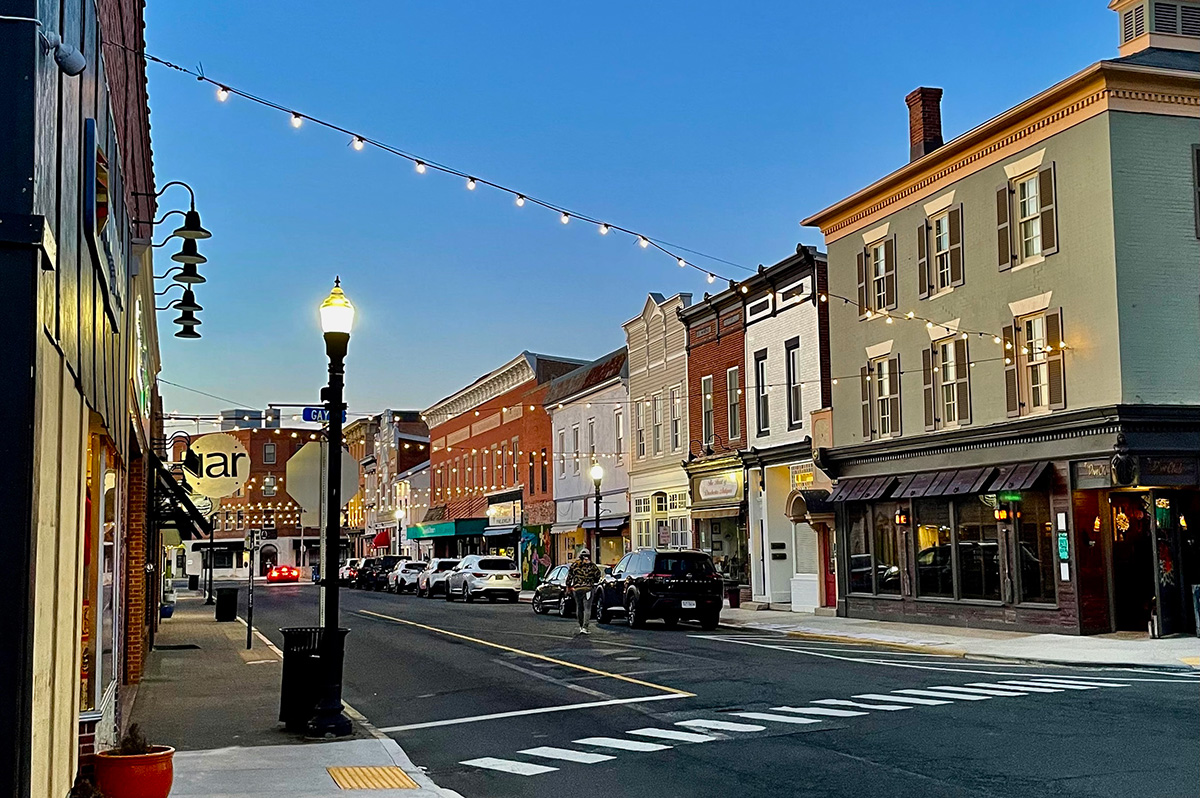
CAMBRIDGE, Md. — Driving through this scenic, historic town on Maryland’s Eastern Shore, you’ll be charmed by streets lined with unique shops, restaurants, and beautifully restored Victorian homes. You’ll also be struck by the number of LGBTQ Pride flags flying throughout the town.
The flags are a reassuring signal that everyone is welcome here, despite the town’s location in ruby red Dorchester County, which voted for Donald Trump over Kamala Harris by a lopsided margin. But don’t let that deter you from visiting. A new organization, Proudly Cambridge, is holding its debut Pride event this weekend, touting the town’s welcoming, inclusive culture.
“We stumbled on a beautiful secret and we wanted to help get the word out,” said James Lumalcuri of the effort to create Proudly Cambridge.
The organization celebrates diversity, enhances public spaces, and seeks to uplift all that Cambridge has to share, according to its mission statement, under the tagline “You Belong Here.”
The group has so far held informal movie nights and a picnic and garden party; the launch party is June 28 at the Cambridge Yacht Club, which will feature a Pride celebration and tea dance. The event’s 75 tickets sold out quickly and proceeds benefit DoCo Pride.
“Tickets went faster than we imagined and we’re bummed we can’t welcome everyone who wanted to come,” Lumalcuri said, adding that organizers plan to make “Cheers on the Choptank” an annual event with added capacity next year.
One of the group’s first projects was to distribute free Pride flags to anyone who requested one and the result is a visually striking display of a large number of flags flying all over town. Up next: Proudly Cambridge plans to roll out a program offering affirming businesses rainbow crab stickers to show their inclusiveness and LGBTQ support. The group also wants to engage with potential visitors and homebuyers.
“We want to spread the word outside of Cambridge — in D.C. and Baltimore — who don’t know about Cambridge,” Lumalcuri said. “We want them to come and know we are a safe haven. You can exist here and feel comfortable and supported by neighbors in a way that we didn’t anticipate when we moved here.”
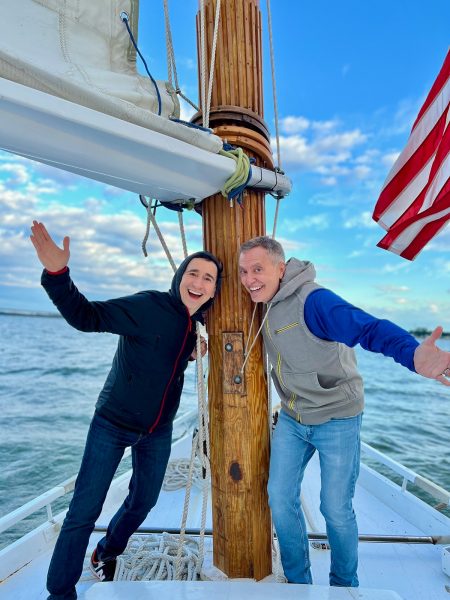
Lumalcuri, 53, a federal government employee, and his husband, Lou Cardenas, 62, a Realtor, purchased a Victorian house in Cambridge in 2021 and embarked on an extensive renovation. The couple also owns a home in Adams Morgan in D.C.
“We saw the opportunity here and wanted to share it with others,” Cardenas said. “There’s lots of housing inventory in the $300-400,000 range … we’re not here to gentrify people out of town because a lot of these homes are just empty and need to be fixed up and we’re happy to be a part of that.”
Lumalcuri was talking with friends one Sunday last year at the gazebo (affectionately known as the “gayzebo” by locals) at the Yacht Club and the idea for Proudly Cambridge was born. The founding board members are Lumalcuri, Corey van Vlymen, Brian Orjuela, Lauren Mross, and Caleb Holland. The group is currently working toward forming a 501(c)3.
“We need visibility and support for those who need it,” Mross said. “We started making lists of what we wanted to do and the five of us ran with it. We started meeting weekly and solidified what we wanted to do.”
Mross, 50, a brand strategist and web designer, moved to Cambridge from Atlanta with her wife three years ago. They knew they wanted to be near the water and farther north and began researching their options when they discovered Cambridge.
“I had not heard of Cambridge but the location seemed perfect,” she said. “I pointed on a map and said this is where we’re going to move.”
The couple packed up, bought a camper trailer and parked it in different campsites but kept coming back to Cambridge.
“I didn’t know how right it was until we moved here,” she said. “It’s the most welcoming place … there’s an energy vortex here – how did so many cool, progressive people end up in one place?”
Corey van Vlymen and his husband live in D.C. and were looking for a second home. They considered Lost River, W.Va., but decided they preferred to be on the water.
“We looked at a map on both sides of the bay and came to Cambridge on a Saturday and bought a house that day,” said van Vlymen, 39, a senior scientist at Booz Allen Hamilton. They’ve owned in Cambridge for two years.
They were drawn to Cambridge due to its location on the water, the affordable housing inventory, and its proximity to D.C.; it’s about an hour and 20 minutes away.
Now, through the work of Proudly Cambridge, they hope to highlight the town’s many attributes to residents and visitors alike.
“Something we all agree on is there’s a perception problem for Cambridge and a lack of awareness,” van Vlymen said. “If you tell someone you’re going to Cambridge, chances are they think, ‘England or Massachusetts?’”
He cited the affordability and the opportunity to save older, historic homes as a big draw for buyers.
“It’s all about celebrating all the things that make Cambridge great,” Mross added. “Our monthly social events are joyful and celebratory.” A recent game night drew about 70 people.
She noted that the goal is not to gentrify the town and push longtime residents out, but to uplift all the people who are already there while welcoming new visitors and future residents.
They also noted that Proudly Cambridge does not seek to supplant existing Pride-focused organizations. Dorchester County Pride organizes countywide Pride events and Delmarva Pride was held in nearby Easton two weeks ago.
“We celebrate all diversity but are gay powered and gay led,” Mross noted.
To learn more about Proudly Cambridge, visit the group on Facebook and Instagram.
What to see and do
Cambridge, located 13 miles up the Choptank River from the Chesapeake Bay, has a population of roughly 15,000. It was settled in 1684 and named for the English university town in 1686. It is home to the Harriet Tubman Museum, mural, and monument. Its proximity to the Blackwater National Wildlife Refuge makes it a popular stop for birders, drawn to more than 27,000 acres of marshland dubbed “the Everglades of the north.”
The refuge is walkable, bikeable, and driveable, making it an accessible attraction for all. There are kayaking and biking tours through Blackwater Adventures (blackwateradventuresmd.com).
Back in town, take a stroll along the water and through historic downtown and admire the architecture. Take in the striking Harriet Tubman mural (424 Race St.). Shop in the many local boutiques, and don’t miss the gay-owned Shorelife Home and Gifts (421 Race St.), filled with stylish coastal décor items.
Stop for breakfast or lunch at Black Water Bakery (429 Race St.), which offers a full compliment of coffee drinks along with a build-your-own mimosa bar and a full menu of creative cocktails.
The Cambridge Yacht Club (1 Mill St.) is always bustling but you need to be a member to get in. Snapper’s on the water is temporarily closed for renovations. RaR Brewing (rarbrewing.com) is popular for craft beers served in an 80-year-old former pool hall and bowling alley. The menu offers burgers, wings, and other bar fare.
For dinner or wine, don’t miss the fantastic Vintage 414 (414 Race St.), which offers lunch, dinner, wine tasting events, specialty foods, and a large selection of wines. The homemade cheddar crackers, inventive flatbreads, and creative desserts (citrus olive oil cake, carrot cake trifle) were a hit on a recent visit.
Also nearby is Ava’s (305 High St.), a regional chain offering outstanding Italian dishes, pizzas, and more.
For something off the beaten path, visit Emily’s Produce (22143 Church Creek Rd.) for its nursery, produce, and prepared meals.
“Ten minutes into the sticks there’s a place called Emily’s Produce, where you can pay $5 and walk through a field and pick sunflowers, blueberries, you can feed the goats … and they have great food,” van Vlymen said.
As for accommodations, there’s the Hyatt Regency Chesapeake Bay (100 Heron Blvd. at Route 50), a resort complex with golf course, spa, and marina. Otherwise, check out Airbnb and VRBO for short-term rentals closer to downtown.
Its proximity to D.C. and Baltimore makes Cambridge an ideal weekend getaway. The large LGBTQ population is welcoming and they are happy to talk up their town and show you around.
“There’s a closeness among the neighbors that I wasn’t feeling in D.C.,” Lumalcuri said. “We look after each other.”
a&e features
James Baldwin bio shows how much of his life is revealed in his work
‘A Love Story’ is first major book on acclaimed author’s life in 30 years

‘Baldwin: A Love Story’
By Nicholas Boggs
c.2025, FSG
$35/704 pages
“Baldwin: A Love Story” is a sympathetic biography, the first major one in 30 years, of acclaimed Black gay writer James Baldwin. Drawing on Baldwin’s fiction, essays, and letters, Nicolas Boggs, a white writer who rediscovered and co-edited a new edition of a long-lost Baldwin book, explores Baldwin’s life and work through focusing on his lovers, mentors, and inspirations.
The book begins with a quick look at Baldwin’s childhood in Harlem, and his difficult relationship with his religious, angry stepfather. Baldwin’s experience with Orilla Miller, a white teacher who encouraged the boy’s writing and took him to plays and movies, even against his father’s wishes, helped shape his life and tempered his feelings toward white people. When Baldwin later joined a church and became a child preacher, though, he felt conflicted between academic success and religious demands, even denouncing Miller at one point. In a fascinating late essay, Baldwin also described his teenage sexual relationship with a mobster, who showed him off in public.
Baldwin’s romantic life was complicated, as he preferred men who were not outwardly gay. Indeed, many would marry women and have children while also involved with Baldwin. Still, they would often remain friends and enabled Baldwin’s work. Lucien Happersberger, who met Baldwin while both were living in Paris, sent him to a Swiss village, where he wrote his first novel, “Go Tell It on the Mountain,” as well as an essay, “Stranger in the Village,” about the oddness of being the first Black person many villagers had ever seen. Baldwin met Turkish actor Engin Cezzar in New York at the Actors’ Studio; Baldwin later spent time in Istanbul with Cezzar and his wife, finishing “Another Country” and directing a controversial play about Turkish prisoners that depicted sexuality and gender.
Baldwin collaborated with French artist Yoran Cazac on a children’s book, which later vanished. Boggs writes of his excitement about coming across this book while a student at Yale and how he later interviewed Cazac and his wife while also republishing the book. Baldwin also had many tumultuous sexual relationships with young men whom he tried to mentor and shape, most of which led to drama and despair.
The book carefully examines Baldwin’s development as a writer. “Go Tell It on the Mountain” draws heavily on his early life, giving subtle signs of the main character John’s sexuality, while “Giovanni’s Room” bravely and openly shows a homosexual relationship, highly controversial at the time. “If Beale Street Could Talk” features a woman as its main character and narrator, the first time Baldwin wrote fully through a woman’s perspective. His essays feel deeply personal, even if they do not reveal everything; Lucian is the unnamed visiting friend in one who the police briefly detained along with Baldwin. He found New York too distracting to write, spending his time there with friends and family or on business. He was close friends with modernist painter Beauford Delaney, also gay, who helped Baldwin see that a Black man could thrive as an artist. Delaney would later move to France, staying near Baldwin’s home.
An epilogue has Boggs writing about encountering Baldwin’s work as one of the few white students in a majority-Black school. It helpfully reminds us that Baldwin connects to all who feel different, no matter their race, sexuality, gender, or class. A well-written, easy-flowing biography, with many excerpts from Baldwin’s writing, it shows how much of his life is revealed in his work. Let’s hope it encourages reading the work, either again or for the first time.
-

 U.S. Supreme Court2 days ago
U.S. Supreme Court2 days agoSupreme Court to consider bans on trans athletes in school sports
-

 Out & About2 days ago
Out & About2 days agoCelebrate the Fourth of July the gay way!
-

 Virginia2 days ago
Virginia2 days agoVa. court allows conversion therapy despite law banning it
-

 Maryland4 days ago
Maryland4 days agoLGBTQ suicide prevention hotline option is going away. Here’s where else to go in Md.



